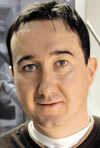Advertisement
Grab your lab coat. Let's get started
Welcome!
Welcome!
Create an account below to get 6 C&EN articles per month, receive newsletters and more - all free.
It seems this is your first time logging in online. Please enter the following information to continue.
As an ACS member you automatically get access to this site. All we need is few more details to create your reading experience.
Not you? Sign in with a different account.
Not you? Sign in with a different account.
ERROR 1
ERROR 1
ERROR 2
ERROR 2
ERROR 2
ERROR 2
ERROR 2
Password and Confirm password must match.
If you have an ACS member number, please enter it here so we can link this account to your membership. (optional)
ERROR 2
ACS values your privacy. By submitting your information, you are gaining access to C&EN and subscribing to our weekly newsletter. We use the information you provide to make your reading experience better, and we will never sell your data to third party members.
Synthesis
Leonard R. MacGillivray
February 12, 2007
| A version of this story appeared in
Volume 85, Issue 7
It was literally Leonard R. MacGillivray's first day at Saint Mary's University in Halifax, Nova Scotia, when he met a chemist who was to have a profound influence on his life and career. Professor Michael J. Zaworotko introduced MacGillivray to the world of organic solid-state research, an arena in which MacGillivray is being honored for his pioneering work bridging the gap between supramolecular chemistry and organic synthesis. Now an associate professor of chemistry at the University of Iowa, MacGillivray, 35, is already an internationally recognized researcher who says he sees "the solid state as a synthetic playground."
Zaworotko provided an "extremely supportive environment in which to explore chemistry," MacGillivray says. "Dr. Z was my undergraduate adviser, and he also ended up being my general chemistry instructor. He has always welcomed undergraduates into his lab. There, I was introduced to the nuts and bolts of an active academic life. I was hooked."
MacGillivray's four years in the Zaworotko lab produced some 20 publications. University of Montreal chemistry professor James D. Wuest says that when he met the undergrad MacGillivray, "I mistook him for a senior grad student or postdoc because of his impressive knowledge of crystallography and his ability to describe the objectives of his research with clarity and passion."
As he received a B.S. with honors from Saint Mary's in 1994, MacGillivray's achievements were recognized with one of the 100 1967 scholarships then awarded annually by Canada's Natural Sciences & Engineering Research Council. The stipend supported his graduate studies with chemistry professor Jerry L. Atwood at the University of Missouri, Columbia.
Atwood, too, proved to be an influential mentor to MacGillivray. Among the work they accomplished together was a 1997 Nature paper that is considered a classic. Atwood and MacGillivray discovered that bowl-shaped calixarenes self-assemble with water molecules into an unprecedented supramolecular sphere with a vast interior cavity. The "design concept is now being studied by many groups worldwide," notes Zaworotko, who is now chairman of the department of chemistry at the University of South Florida.
After earning his Ph.D. in 1998, MacGillivray joined the National Research Council of Canada's Steacie Institute for Molecular Sciences. The unique program allowed him to pursue his own research interests independently at a career stage when most young scientists are postdocs. It was there that he began exploring the use of molecular recognition and self-assembly to control organic reactions in the solid state.
"It's been known for 100 years that if olefins crystallize so their double bonds are aligned parallel at just the right distance, you can irradiate them with ultraviolet light and form cyclobutanes," MacGillivray says. "I wondered how you could take this simple, solvent-free, carbon-carbon bond-forming reaction and make a variety of products. It's difficult because the arrangements of molecules in crystals are sensitive to subtle changes to molecular structure."
MacGillivray hit upon using templates to organize the olefin reactants, employing noncovalent bonds to control structure and properties just as nature does. His group's most spectacular success has been the quantitative synthesis of ladderanes, fragments of natural products featuring a series of fused cyclobutane rings (C&EN, Jan. 5, 2004, page 13).
"Len has, in effect, spawned the development of a new field of supramolecular chemistry and organic synthesis," Zaworotko says of MacGillivray's work in template-controlled solid-state synthesis.
MacGillivray's other research interests include the development of organic semiconductor materials and the synthesis of pharmaceutical cocrystals. As Zaworotko notes, a thread connecting all aspects of MacGillivray's independent research is "thinking green," including "setting ground rules for more general use of renewable feedstocks that can be accomplished via the solid state—that is, solvent-free and with little or no waste."
MacGillivray joined the University of Iowa as an assistant professor in 2000 and was promoted ahead of schedule to his current position of associate professor in 2005. Among his many honors and awards, he was elected a fellow of the Royal Society of Chemistry in 2005. He serves as an editor or on the editorial boards of a number of scholarly journals and is editor-in-chief of the new journal Molecular & Supramolecular Materials.





Join the conversation
Contact the reporter
Submit a Letter to the Editor for publication
Engage with us on Twitter